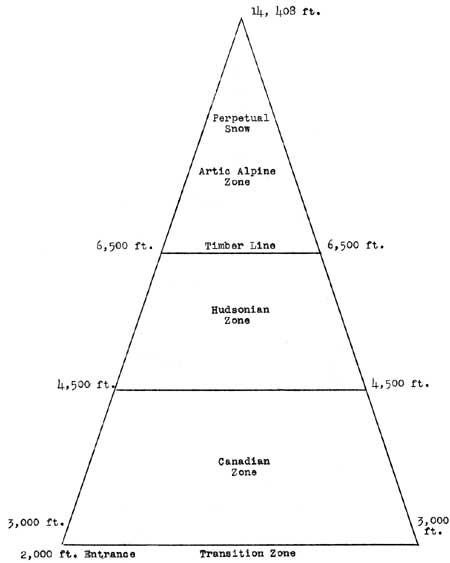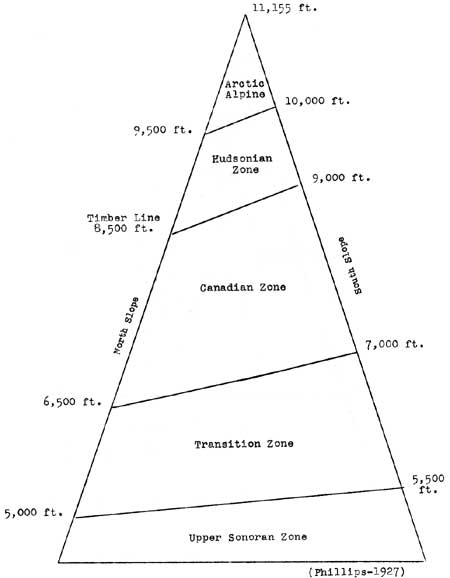
Perhaps you have wondered, whenever you have visited Mount Rainier
National Park, why you habitually find certain animals or plants at
fixed localities upon "The Mountain's" broad flanks while at other
places an entirely different assortment of flora and fauna is present.
This distribution of plant and animal life offers an interesting subject
for study or speculation. On Mount Rainier it is greatly varied and
complicated by a number of factors - chief of which is change in
altitude.
Generally speaking a change in latitude of 800 miles poleward is
equal to an ascent of one mile in altitude. Also the average change in
temperature due to change in altitude is about 1 degree for every 300
feet but on Mount Rainier these differences are more pronounced. This is
because "The Mountain" is an isolated peak and, as such, is much exposed
to radiation. An elevation equivalent to Mt. Rainier on a plateau is
greatly influenced by the great bulk of the plateau which absorbs more
heat and radiates it slower than a single exposed mountain such as this
which stands alone and overtops, by 8000 ft., its closest competitors in
height. In addition Mt. Rainier is still in the "glacial age"
(approximately 50 square miles of surface area are covered with
perpetual ice) and thus absorbs little heat even on a hot day and being
entirely surrounded by moving air currents radiates its heat with great
rapidity. The air is thinner upon the upper slopes of Rainier (an
average barometric pressure of 30 inches at sea level means that a
pressure of about 17 inches will be found on the summit of this
mountain) and this allows the actinic rays of the sun to pass through
more readily causing severe sunburn. Many a mountain climber has found
this out to his sorrow but it is also interesting to note that although
the sun's rays pass through this thin air with much more heat they cause
little change in air temperature. Instead it is used up in melting the
snow. Why then do we not find considerable running water upon the snow
surfaces of the upper elevations? This is explained by the dry air at
that altitude. The snow surface disappears without visible water, its
melting being irregular which brings about the honey-comb structure
found on the upper snow surfaces. While the air is somewhat modified by
the heat of the sun's rays, direct or indirect, a noticeable change in
temperature is characteristic here as soon as the sun sets for then the
source of the heat is shut off, radiation into the thin air is very
rapid and the air is soon very chilly. Being heavier than the warmer air
it slides down the slopes of "The Mountain" into the lower valleys and
helps to bring the colder upper temperatures into the lower valleys.
This is particularly noticeable if one stands in one of the numerous
valleys or glacial troughs in this park. After sundown a cold draught
will be experienced while the slopes immediately above it will often be
much warmer.

Life Zones in Mount Rainier National Park

Life Zones in Yellowstone National Park
Life zones on Mt. Rainier show corresponding changes. Tree line on
the Rocky Mountains is from 9000 to 10000 feet in the same latitude and
Arctic Alpine, Hudsonian and other zones are correspondingly higher than
upon Mt. Rainier. Tree line on Mt. Rainier is from 6500 to 7500 feet and
the Hudsonian zone, corresponding in plant and animal life to the
latitude of Hudson Bay and here, the zone of greatest flower development
is between 4500 and 6500 feet while the Hudsonian zone in Yellowstone
National Park is 9000 to 10000 feet on south slopes.
Tree line as well as distribution into plant zones is along irregular
lines due to factors other than altitude alone. There are a number of
these factors to only a few of which we can call attention in this
article. Tree line and plant distribution differs on the North and South
slopes of Mt. Rainier. Snow fall is much heavier on the south and west
slopes but on the other hand south and west slopes are inclined to the
sun and receive the more direct rays and are warmer. Contrary to common
belief park lands on the north side of mountain are free from snow
earlier in the season than parks at the same altitude on the south side
and on an average have a more dry climate. As an example of this factor
in plant distribution Spruce and Ceanothus are quite common on the North
side of the mountain and not found on the South side.
Glacier tongues also extend far down toward the base of the mountain
and glacial streams extend below these. Both of these carry the colder
temperatures from above down into the lower altitudes and arctic alpine
flowers are found not only along the edge and at the ends of the
glaciers but for several miles below along the edge of the glacial
streams. At Longmire five miles below the end of Nisqually glacier one
can find along the bowlder strewn stream course several plants that
normally live at much higher altitudes.
Local disturbances of zonal distribution such as slope, streams,
winds and snowfall are much more noticeable on Mt. Rainier than in
latitude affects because of the compressed character of the zones on Mt.
Rainier. Fifty or one hundred miles of latitude will now show many times
as great a change in plants as the same number of feet will show on the
mountain. This is well shown at the end of Nisqually glacier where large
trees are growing at the same altitude as the arctic alpine plants near
the glacier's edge.
Soil and moisture are both important factors in plant distribution.
Both of these factors along with exposure to winds greatly effect tree
line. Many ridges are devoid of soil especially at high elevation and
most of the soil found at high elevation is pumice. Both rock ridge and
pumice are xerophytic or dry habitats and unfavorable to tree growth but
quite favorable to other plants of more hardy character.
The region above the tree line, the arctic-alpine, is a region of
rock ridge, pumice slope and snow and ice. The plants of this region are
all stunted because of adverse conditions of growth. These adverse
conditions however make this region the most definite of all the plant
zones on the mountain. Only a few plants are able to adapt themselves to
this harsh habitat. The arctic-alpine plants differ little throughout
the whole Cascade Sierra Nevada range and are partly remnants of the
arctic plants driven southward by the ice advance of the glacial period.
At the close of the glacial period many of these plants followed up the
retreat of the glaciers northward. But a great many finding the same
arctic conditions of environment upon our high mountains have remained
and are now marooned on our barren mountain tops surrounded by much more
favorable conditions. The Ptarmigan, an arctic bird, is the only animal
of this region having the same relationship to the glacial age as the
arctic plants. This bleak habitat seems to be preferred by this bird and
these plants.
"There is no Northern shore so bleak
No mountain top so bare
There is no desert so accursed
But God's gems blossom there."
Charles Landes,
Ranger-Naturalist.

